Corticobulbar tract Study guides, Study notes & Summaries
Looking for the best study guides, study notes and summaries about Corticobulbar tract? On this page you'll find 59 study documents about Corticobulbar tract.
Page 4 out of 59 results
Sort by
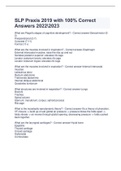
-
SLP Praxis 2019 with 100% Correct Answers 2022-2023
- Exam (elaborations) • 80 pages • 2023
- Available in package deal
-
- R260,20
- + learn more
What are Piaget's stages of cognitive development? - Correct answer-Sensorimotor (0- 2) Preoperational (2-7) Concrete (7-11) Formal (11+) What are the muscles involved in inspiration? - Correct answer-Diaphragm External intercostal muscles: raise the ribs up and out Serrates posterior superior: elevates rib cage Levator costarium brevis: elevates rib cage Levator costarum logies: elevates rib cage What are the muscles involved in expiration? - Correct answer-Internal intercostal muscl...

-
SLP Praxis 1- Anatomy and Physiology exam 2022/2023 with 100% correct answers
- Exam (elaborations) • 9 pages • 2022
-
- R183,05
- + learn more
Parts involved in Respiration lungs, bronchi, trachea, spinal column, sternum, rib cage Muscles of Respiration diaphragm, Abdominals, and Intercostals Intercostals 11 pairs of internal intercostals pull thorax down and in for exhalation, 11 pairs of external intercostals pull thorax up and out for inhalation Diaphragm muscle at floor of chest cavity that separates abdomen and thorax. Plays major role in breathing and is almost the only muscle used in passive breathing. ...
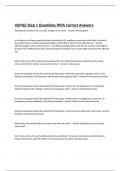
-
USMLE Step 1 Questions With Correct Answers
- Exam (elaborations) • 184 pages • 2023
- Available in package deal
-
- R347,00
- + learn more
What gland is found in the muscular triangle of the neck? - Answer Thyroid gland Is an afferent or efferent pupillary defect described as B/L pupillary constriction when light is shined in the unaffected eye and B/L paradoxical dilation when light is shined in the affected eye? - Answer Afferent pupillary defect (CN II lesion); in an efferent pupillary defect (CN III), B/L constrict when light is shined in the unaffected eye and consentual pupil constriction occurs when light is shined in the...
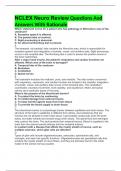
-
NCLEX Neuro Review Questions And Answers With Rationale
- Exam (elaborations) • 48 pages • 2024
-
- R260,20
- + learn more
NCLEX Neuro Review Questions And Answers With Rationale Which statement is true for a patient who has pathology in Wernicke's area of the cerebrum? A. Receptive speech is affected. B. The parietal lobe is involved. C. Sight processing is abnormal. D. An abnormal Romberg test is present. A The temporal, not parietal, lobe contains the Wernicke area, which is responsible for receptive speech and integration of somatic, visual, and auditory data. Sight processing occurs in the occipital lob...
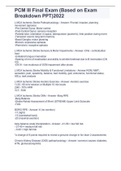
-
PCM III Final Exam (Based on Exam Breakdown PPT)2022
- Exam (elaborations) • 17 pages • 2022
- Available in package deal
-
- R289,14
- + learn more
L MCA Ischemic Stroke Pathophysiology -Frontal: impulse, planning movement (apraxia) -Pre-Central Gyrus: Motor control -Post-Central Gyrus: sensory reception -Parietal lobe: orientation in space, lateropulsion (pusher's), limb position during mvmt -Temporal: sound, long term memory -Basal Ganglia: motor planning -Broca's: expressive aphasia -Wernicke's: receptive aphasia L MCA Ischemic Stroke Sensory & Motor Impairments -CNs - corticobulbar tract -Unilateral tongue innervatio...
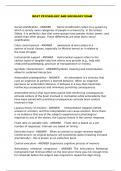
-
MCAT PSYCHOLOGY AND SOCIOLOGY EXAM
- Exam (elaborations) • 140 pages • 2023
- Available in package deal
-
- R308,43
- + learn more
MCAT PSYCHOLOGY AND SOCIOLOGY EXAM Social stratification - ANSWER Social stratification refers to a system by which a society ranks categories of people in a hierarchy. In the United States, it is perfectly clear that some groups have greater status, power, and wealth than other groups. These differences are what led to social stratification Class consciousness - ANSWER awareness of one's place in a system of social classes, especially (in Marxist terms) as it relates to the class struggle....
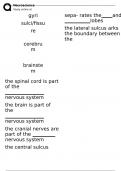
-
Neuroscience Exploring the Brain 4th edition Test Bank
- Exam (elaborations) • 29 pages • 2023
-
- R252,49
- + learn more
gyri sulci/fissure cerebrum brainstem the spinal cord is part of the nervous system the brain is part of the nervous system the cranial nerves are part of the nervous system the central sulcus sepa- rates the and lobes the lateral sulcus arks the boundary between the convolutions depressions two hemispheres each containing the cerebral cortex and diencephalon mid brain, pons, medulla oblongata central central peripheral frontal, parietal frontal, temporal ...
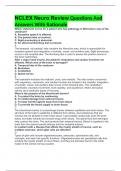
-
NCLEX Neuro Review Questions And Answers With Rationale
- Exam (elaborations) • 48 pages • 2024
-
- R267,92
- + learn more
NCLEX Neuro Review Questions And Answers With Rationale Which statement is true for a patient who has pathology in Wernicke's area of the cerebrum? A. Receptive speech is affected. B. The parietal lobe is involved. C. Sight processing is abnormal. D. An abnormal Romberg test is present. A The temporal, not parietal, lobe contains the Wernicke area, which is responsible for receptive speech and integration of somatic, visual, and auditory data. Sight processing occurs in the occipital lob...
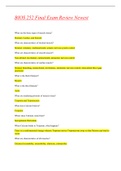
-
Biology 252 Final exam review completed ; Answers provided
- Exam (elaborations) • 11 pages • 2022
-
- R433,99
- + learn more
Biology 252 Final exam review completed ; Answers provided BIOS 252 Final Exam Review Newest What are the three types of muscle tissue? Skeletal, Cardiac, and Smooth What are characteristics of skeletal muscle? Striated, voluntary, multinucleated, somatic nervous system control What are characteristics of smooth muscle? Non-striated, involuntary, uninucleated, autonomic nervous control What are characteristics of cardiac muscle? Striated, branching, uninucleated, involuntary, auto...

-
SPLH 620 Exam 3 Questions with Complete Solutions
- Exam (elaborations) • 11 pages • 2024
- Available in package deal
-
- R246,70
- + learn more
SPLH 620 Exam 3 Questions with Complete Solutions motor cortex - Answer-controls voluntary movements primary motor cortex - Answer--receives sensory input from the cerebellum via. thalamus -sends info. to the spinal cord & brainstem -sends info to corticospinal or corticobulbar tract premotor cortex - Answer-The region controlling learned motor skills. -receives input from posterior parietal & visual cortexes lesions in premotor cortex - Answer-cause an inability to perform purpo...

How did he do that? By selling his study notes on Stuvia. Try it yourself! Discover all about earning on Stuvia


